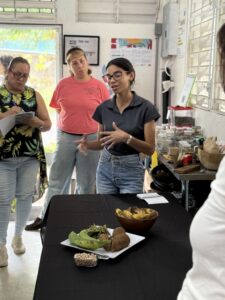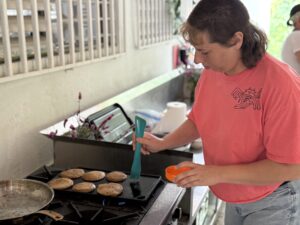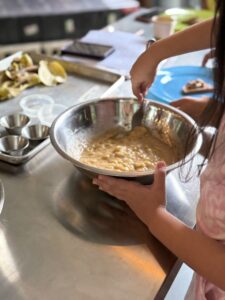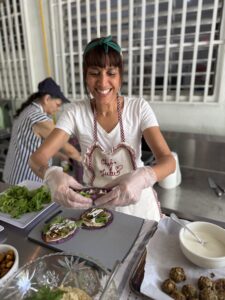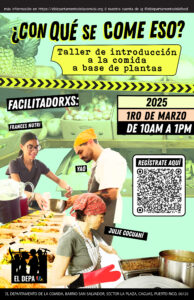Progress report for FLW24-009
Project Information
El Departamento de la Comida will serve as a leader in developing best practices to build capacity within rural farms, food hubs, small businesses, and community groups to reduce food loss/waste (FLW) through refining and sharing our replicable, scalable food hub model for FLW reduction. We envision our role in reducing FLW as similar to the role of mycelium in soil—to nourish, sustain, and create connections between producers, consumers, and food. This project addresses the prevalent issue of FLW in Caguas, Puerto Rico by implementing a multifaceted strategy centered on community engagement, education, and innovative food recovery methods.
Collaborating with the University of Puerto Rico-Mayagüez, our initiative begins with the development of a comprehensive vulnerability map. We will develop a map of our local ecosystem of markets, farmers, and consumers to determine where and why food loss and waste occurs in our communities. This research will provide crucial information that will allow us to focus our efforts on critical areas, and track changes in the locations and distribution of vulnerable sites over time.
Key objectives of the project include creating pathways for food rescue and educating local farmers on sustainable production practices to minimize surplus. Over a three-year period, we will partner with Trito Agro-Industrial Services to implement tailored solutions for underserved farmers and food businesses, emphasizing producing only what is needed, integrating improved harvesting and storage techniques, and planning for natural disasters. Concurrently, surplus produce will be rescued and transformed into shelf-stable products through our food hub kitchen, reducing waste while increasing economic opportunities for farmers.
Central to our approach is the establishment of our food hub kitchen as a test site for developing and refining standard operating procedures to minimize FLW while upcycling produce. Our food hub will also provide nutritious meals to food-insecure community members. Through educational workshops and cooking classes, we will empower residents to adopt practices that simultaneously reduce FLW in homes and support local agriculture. This initiative strengthens food sovereignty and fosters a resilient local food system capable of withstanding external shocks, such as natural disasters.
Evaluation will be integral to our project’s success. We will track the impact of our activities on underserved farmers and communities, measure the volume of food recovered, and align with regional priorities for FLW initiatives. By continuously evaluating and adapting our strategies based on data-informed insights, we will achieve sustainable reductions in FLW, enhance economic vitality, and promote food security throughout Caguas.
Our project represents a holistic and community-driven approach to tackling FLW, leveraging local partnerships and innovation to create lasting positive change in Puerto Rico’s food landscape. By empowering stakeholders and implementing evidence-based practices, we envision a future where FLW is minimized, and every community member has access to nutritious food options. The lessons learned and materials produced through this project will be disseminated to other food rescue organizations as a replicable and scalable model of successfully implementing FLW in communities that are systemically underserved and overburdened by the impacts of climate change.
- Develop a vulnerability map of our local ecosystem, including markets, community kitchens, food retailers, farmers, and schools to determine where and why FLW occurs. Analyze and share the data collected to inform project activities.
- Create pathways to strengthen food rescue from 10 local farms or food businesses and educate them to identify FLW in their operations, learn to reduce the volume of surplus food generated, and determine other ways to increase crops utilized or sold.
- Refine and codify standard operating procedures for our Kitchen program to minimize FLW of bought, donated, and rescued food during processing and other operations.
- Identify the quantity of surplus produce within our food chain and donate to other community groups as well as transform at least 25% into value-added and shelf-stable products annually through our Kitchen program, workshops, and point of sale.
- Provide value-added and shelf-stable products to community members experiencing food and/or nutrition insecurity and for events like natural disasters where it is likely food access will be a greater need.
- Work with producers and farmers to improve animal nutrition through diverted surplus food converted to feed.
- Grow our capacity to host educational and training workshops for our community focused on reducing FLW, sharing actionable practices and community-based strategies and preparing culturally-significant, traditional meals.
- Engage in a constant cycle of evaluation of data collected and trainings offered to incorporate iterative changes for continuous, responsive improvement of the project.
- Strengthen supply chain resiliency in San Salvador and neighboring communities connected to our food system in order to increase community self-reliance in providing for our own food needs.
- Serve as a leader in developing best practices to build capacity within rural farms, food hubs, small businesses, and community groups to reduce FLW through refining and sharing our replicable, scalable food hub model for FLW reduction.
Cooperators
- - Technical Advisor (Researcher)
Research
The initial months of "Que no se pierda la cosecha" have focused on building a foundational system for data collection, particularly within our own kitchen and food hub. Since we are still in the development of this standardisation, our methods are still very basic, with hopes of improving after our initial food audit.
Data Collection Activities and Materials
The primary activity involved in our current data collection strategy is logging crops as they are received through purchase or donation. Upon arrival, each batch of crops is weighed, and the weight is logged into a crop log. This logging system helps us track the amount of food that is diverted from farmers and distributors to our operations, providing a preliminary understanding of the scale of surplus produce. The materials used for data collection include:
-
A basic crops log to record data on incoming produce (e.g., weight, type of crop, source of donation or purchase)
-
Weighing scales to determine the exact weight of crops when received
Measurement Strategies and Rationale
Currently, our measurement strategy focuses on recording the weight of crops as they are received. The rationale behind this method is to establish a baseline understanding of the volume of surplus crops entering our system. By quantifying this surplus, we can begin to assess the scope of food loss and waste within our immediate supply chain and determine the potential for repurposing or redistributing these crops to reduce waste.
In the next phase of our data collection, we plan to conduct a kitchen audit. This will provide a more detailed snapshot of where food loss occurs in our operations, and will allow us to create targeted strategies to minimize waste, improve efficiency, and enhance food recovery methods.
Methods for Reducing Food Loss and Waste
Our methods for reducing food loss and waste have focused on two key strategies: gleaning surplus produce and donating or upcycling that produce. These methods are essential in addressing food waste while simultaneously contributing to community nutrition and food security.
-
Gleaning Surplus Produce: We actively work with local farmers and distributors to collect surplus crops that would otherwise go to waste. This produce, which includes items such as overripe fruits and vegetables, is redirected to our kitchen for preparation or donation. By rescuing this surplus, we are preventing food waste at the point of origin and diverting it into beneficial uses for our community.
-
Upcycling and Donating: The surplus produce gleaned is utilized in multiple ways to minimize waste and support the community:
-
Meal Preparation: Surplus produce is incorporated into the preparation of nutritious lunches for community members as part of our "Comidas pal Barrio" program
-
Value-Added Products: Some surplus items are turned into value-added products, such as jams, sauces, or dehydrated goods, which are sold and distributed to increase the shelf life of native easily perishable foods and provide additional sources of nourishment
-
Donations to Community Members and Kitchens: Fresh produce is also donated to local kitchens and community members who may, addressing food insecurity and ensuring that nutritious food reaches those who can benefit from it.
-
- Farm
- Distribution
- Prevent Wasted Food
- Donate or Upcycle
1. Preventing Wasted Food
Our primary focus in these early stages has been to reduce food loss from the very beginning of the supply chain by tracking and logging crops as they are purchased or donated. Although this system is still in its infancy, we have already made strides in understanding the extent of food loss that occurs during this phase. By weighing and logging the crops upon receipt, we are able to monitor and analyze food loss diverted from farmers and distributors. This logging system, though basic, provides us with insights into the types and quantities of produce that are at risk of being wasted.
In the coming month, we plan to conduct a kitchen audit to establish a baseline of food loss and waste within our internal operations. This audit will allow us to further refine our methods to prevent wasted food, including identifying areas in the kitchen where waste is most prevalent, and developing specific strategies to minimize it. Ultimately, our aim is to prevent food waste not only by diverting surplus crops but also by enhancing the efficiency of our own operations and creating a culture of waste prevention throughout the supply chain.
2. Donating or Upcycling
Our efforts in food recovery also include donating and upcycling surplus produce. We have been gleaning surplus crops from farmers and distributors, which would otherwise go to waste, and repurposing these items in a way that benefits our community. These crops are used in several ways:
-
Preparing nutritious lunches for community members
-
Creating value-added products that can be sold or distributed
-
Donating fresh produce to local kitchens and community members in need
These practices align with the donate or upcycle food recovery method by ensuring that surplus food is either reused or given to those who can benefit from it. Through these initiatives, we are actively contributing to reducing food waste in the region while improving access to nutritious food for underserved populations. By turning surplus produce into meals and products that benefit the community, we not only address food insecurity but also promote sustainability.
We hope in the coming months to create a baseline of data for our kitchen, community members, and our stakeholders.


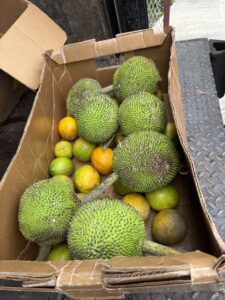
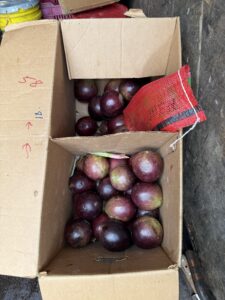
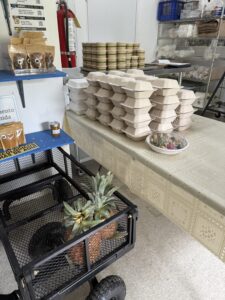
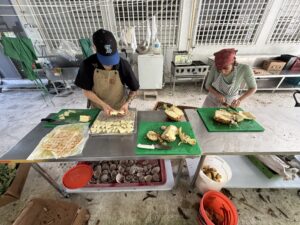
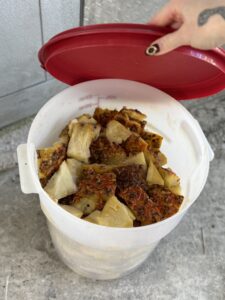 The recovered or diverted food had many destinations and transformations within our food supply chain, with some of them still being processed as this report is being written. Mainly, the recovered and diverted food becomes part of the lunches we serve to the community on a weekly basis. These lunches are complete meals always made from fresh produce, composed of a main dish, side dish, salad, soup, desert, and sometimes even something to drink like juice. We serve 160 meals approximately every week. The produce that doesn't make it to weekly lunches, mainly ones that are about to spoil and processing can't wait, are transformed into value added product. Some examples of the most recent products we have processed into non-perishables are dehydrated pineapple and pineapple vinegar. In some cases, we simply don't have the capacity to process the crops, in which case we donate the crops by setting up a cart next to our weekly lunches pick-up and community members can grab produce freely.
The recovered or diverted food had many destinations and transformations within our food supply chain, with some of them still being processed as this report is being written. Mainly, the recovered and diverted food becomes part of the lunches we serve to the community on a weekly basis. These lunches are complete meals always made from fresh produce, composed of a main dish, side dish, salad, soup, desert, and sometimes even something to drink like juice. We serve 160 meals approximately every week. The produce that doesn't make it to weekly lunches, mainly ones that are about to spoil and processing can't wait, are transformed into value added product. Some examples of the most recent products we have processed into non-perishables are dehydrated pineapple and pineapple vinegar. In some cases, we simply don't have the capacity to process the crops, in which case we donate the crops by setting up a cart next to our weekly lunches pick-up and community members can grab produce freely.
- Produce
So far we have only worked with produce. We expect to form alliances in the coming months with restaurants and markets where these categories will surely be expanded.
We established and continue to strengthen our relationship with farmers and distributors by accepting and even paying for surplus crops that would otherwise go to waste. It has been a trust based system where these stakeholders know that they can come to El Departamento de la Comida and this food will be processed, donated and overall support our communities food security and nutrition.
So far we have been able to build a capable team to carry out our projects objectives, as well as do proper onboarding. The main reason why we have seen some setbacks in our initial timeline has been related to the uncertainty of our current political landscape which has prompted some internal troubleshooting in our organization. We have been able to discuss these challenges and feel confident we have the proper tools and capacity to move the project forward.
Education
"Que no se pierda la cosecha" has a hands on educational approach where we strive to work hand in hand with our stakeholders as a whole systems approach to tackle food loss and waste. So far, we have started to train community members with a plant based cooking workshop. This workshop covered creative and unusual techniques to process and consume some of our most readily available native crops (and thus crops that are more vulnerable in the food loss chain due to excess). By presenting alternative recipes, we transform our communities perspective of certain crops, expanding possibilities of consumption, preventing food loss and increasing nutrition security. Our cooking workshop also included recipes that minimize food waste, like making plant based mayonnaise with "aquafaba", the liquid that results from the water used to cook or soften garbanzos (considered an egg substitute in plant based cooking).
Educational & Outreach Activities
Participation summary:
"¿Con qué se come eso?" Plant-Based Cooking Workshop
On March 1, 2025, we hosted “¿Con qué se come eso?” a plant-based cooking workshop, aimed at introducing our community to healthier, creative alternatives for preparing locally grown crops. This event was designed to address the growing interest within our community to learn more about plant-based cooking techniques using the crops we serve on a weekly basis is our "Comidas pal Barrio". The workshop not only provided valuable education to participants but also engaged with ongoing outreach efforts to promote sustainability, food security, and healthier eating habits in the community.
Activities and Outreach
The workshop, facilitated by key members of our kitchen team—including Julie (Kitchen Director, trained in Ayurvedic practices), Yao (Sous Chef, plant-based cooking expert), and Frances (in-house Nutritionist)—focused on teaching participants how to prepare local crops in innovative and nutritious ways. These crops, although rich in nutrients, are often traditionally prepared in less healthy methods, such as fried ripe plantains. This workshop provided an opportunity to explore new cooking techniques that retain the crops' nutritional value while reducing unhealthy preparation methods.
The outreach efforts tied to the workshop are part of a broader initiative to educate the community about plant-based alternatives that improve the quality of life for local producers, consumers, and the community as a whole. By utilizing crops that are both geographically and economically accessible, participants were introduced to practical recipes that promote healthier living. Additionally, the workshop encouraged reducing food waste by showcasing how to use different parts of the crops, such as skins and overly ripe produce, which would typically be discarded.
The ongoing outreach is aimed at fostering a sustainable food culture within the community. By teaching participants how to create healthy, plant-based meals with readily available crops, we are helping to reduce dependency on imported, low-nutrient foods that many community members rely on. This approach also strengthens food security by encouraging the use of local resources and empowering individuals to produce their own nutritious meals at home.
Audience and Participation
The primary audience for the workshop was the elder community of San Salvador Caguas, aged 60-85, who are often more vulnerable to the effects of poor nutrition. A smaller group of younger participants (ages 25-50) and an 8-year-old child also attended, reflecting the broad interest in plant-based cooking across generations. These community members were particularly interested in learning how to prepare healthy meals with local crops, as many of them were already familiar with these ingredients but lacked the knowledge of healthier preparation methods.
The participation in the workshop was highly interactive, with attendees actively engaging in the cooking process, learning techniques, and sharing their own knowledge of local food traditions. The event created a space for community members to connect, collaborate, and learn from one another, fostering a sense of collective empowerment.
Engagement with Underserved Communities
This workshop was an essential step in engaging with underserved communities by providing education and resources that might otherwise be inaccessible. The elders in particular, who often face barriers to accessing health education and resources, were able to benefit from the workshop’s focus on practical, local solutions to improve their health and nutrition. By offering the workshop in their own community, we were able to meet them where they are, overcoming barriers of transportation and access to outside resources.
In addition, the focus on utilizing local crops that are both abundant and affordable helped ensure that the workshop’s impact reached the most underserved members of the community, who may struggle with food insecurity and limited access to healthier, diverse food options. Through this educational outreach, the project is not only improving health outcomes but also supporting economic sustainability by teaching participants how to make the most of locally grown food.
Project Outcomes
So far our project has contributed to solutions of food loss and waste through the donation of crops, preparation of weekly lunches, and production of value added products. We strive to be a model for other community food hubs and kitchens, and we project these methods can be replicated by other initiatives to minimize food loss and waste. Since our project is just launching our outcomes are minimal, yet impactful, and we look forward to develop more strategies and solutions with our community members, farmers, distributors and food businesses in the coming months.
Based on our current work done in the last few months some recommendations for food loss waste efforts and incresing community self-reliance are:
-
Increase local food education: More workshops on plant-based cooking and food preservation equip individuals with the skills to utilize available resources in their own homes, reducing dependency on external food sources.
-
Support small-scale farming: Supporting and creating relationships with small-scale farming initiatives is crucial to lower reliance on imported food, boosting access to fresh, nutritious.
-
Develop regional food hubs: Establishing food hubs, like El Departamento de la Comida, could streamline food recovery efforts on a broader scale. These hubs could act as distribution points for recovered food, connecting local farmers with community kitchens, and community members.
-
Operational audits and waste reduction goals: As we begin conducting our own kitchen audits to track internal food loss, similar audits should be implemented in other food operations, from small kitchens to large food distributors. These audits can identify where waste occurs and help establish clear waste reduction goals, encouraging organizations to adopt more sustainable practices and create food recovery systems that prevent waste at every stage.
